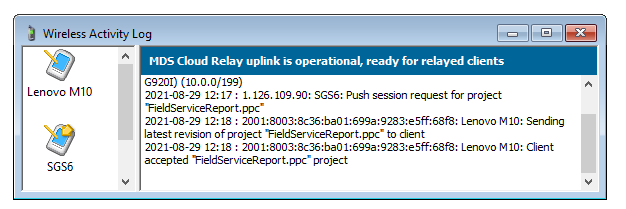Page 7: Android: - Installation and Use
CreativityCorp has responded to the market dominance of the Android operating system for Smartphones, Tablets and other mobile devices by providing 'client side' software for Android that will run projects developed in Mobile Data Studio (MDS) and communicate with the Mobile Data Studio server.Mobile Data for Android moved to the Google Play Store in November2021.Mobile Data for Android is now available for download and installation as for Mobile Data for Apple iOS. The Mobile Data app for Android is compatible with Andoid OS 4.1 and above. This move for Android will simplify the initial installation of the Android mobile client for Mobile Data Studio, facilitate timely upgrades, and enable use with Mobile Device Management Systems such as Microsoft InTune. Mobile Data for Android is available at the Google Play Store for installation to Android devices. The app transition process is very important for current users to ensure preservation and transfer of session data associated with Mobile Data Studio projects. Note Guidance below; for transition process for current users of Mobile Data for Android: Trial or new users can download and install directly from Google Play using links on this web site. Guidance for current users of Mobile Data for Android: 1. Make a note of the Settings of the ‘old’ app. 2. Note the Projects on the old app and open matching Projects on MDS server side. 3. Transfer any Active sessions on the old app to the MDS server. Best to plan this for a low mobile activity time. Take the opportunity to delete stale Sent and Deleted sessions. 4. Connect to Google Play Store with Android devices, download and install Mobile Data, the new app. 5.There will now be two apps to consider; the new app has a dark blue tablet to distinguish it from the old app. Devices displayed in the Wireless Activity window which haven't installed the new app will display a red 'OLD'. 6. Enter Settings on the new app. This could be a good opportunity to trial MDS Cloud Relay, accessed from within Customer Login. 7. Install relevant projects from the MDS server to the new app, and restore relevant sessions to the Active folder of the new app. 8. When satisfied the new app is operational, uninstall/delete the old app, as the transition is complete. Please raise any queries by email to info@mobiledataanywhere.com Apologies for this one-off disruption to achieve greater productivity from Mobile Data for Android. . |
Consider using MDS Cloud Relay to connect MDS Server and android devices, see Skills page 10.
Installation of Mobile Data for Android Software
- File: Android application or program files have the extension .apk, here being MobileData.apk. The current Mobile Data for Android available at the Google Play Store is version 10.4.4 (build 324).
- Download and Install Software: Click on link above to 'Get it on Google Play' to download directly to an Android device. Contact CreativityCorp if you have queries regarding download and install.
- Mobile Data in Programs: After installation of the Mobile Data.app from Google Play, 'Mobile Data' and its 'MDS' icon will appear in Applications (Programs) on Android devices.
- Settings in Mobile Data for Communications:
Mobile Data for Android communicates with the Mobile Data Studio
server using the wireless TCP/IP functions of Mobile Data Studio,
see page 11 Wireless (TCP/IP) functions
or the new MDS Cloud Relay, see page 10.
The Settings menu will present when Mobile Data is first
opened on the Android device. Communication from the Android
device to the Mobile Data Studio server can either be via
the mobile phone network or a WiFi connection. The Server
Address of either or both a Local Area Network or an
externally exposed Internet related Address will be shown in
the Wireless Activity window of Mobile Data Studio. In the alternative to a numeric IP address a text DNS can be
used; for example mds.creativitycorp.com . A screen shot of Listening on IP Address
is shown below, presenting an external IP address
(180.181.187.198) and address of a local WiFi network (10.0.0.1).
The TCP Port by default is 2001, but another may be specified, Password to match that on the Mobile Data Studio server, and Unit ID being the identification assigned to the mobile client device (without space). Options for client server relationship are: Require 256-bit AES encryption, providing a secure 256-bit AES encrypted connection between the mobile client and server (requiring a ten character password); Maintain a continuous connection which enables connection whenever Mobile Data is open and the Mobile Data Studio server is running; Receive new sessions upon connect enables receipt of sessions from the server and should be left on; Automatically submit new sessions enables automatic submission of sessions originating on the mobile device when they are finished; Submit old sessions relates to sessions which have originated on the Mobile Data Studio server, and when enabled submits them on closure of the session; Lock the settings page enables mobile deployment managers to control access to Settings, to un-lock the Settings page the TCP/IP Access Password must be entered; Prevent session duplication prevents duplication of sessions in the Session Folders.
- The Server Address, Port, Password, UnitID, Session management and a Lock of the Settings page can all be set via a URL sent to a mobile device via either email or SMS. Download an example 'Configure mobile device Settings via URL'; and modify for your Settings requirements. Note, the explicit details of Settings in the example shown below would not normally be sent to users, only the URL.
- Note: CreativityCorp does not warranty nor support Mobile Data for Android installed to 'rooted' Android devices; a 'rooted' environment compromises security of data and can have unforeseen affects on software behaviour.
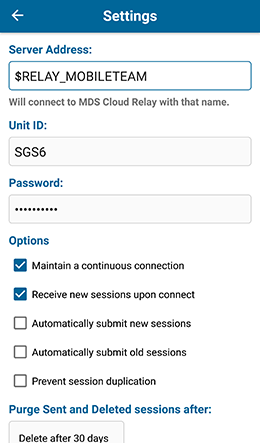 |
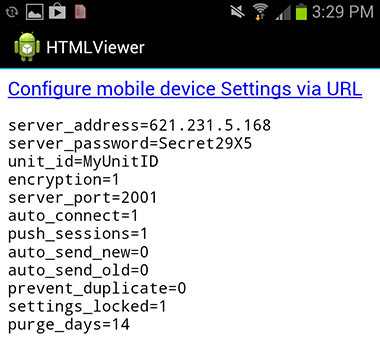 |
Installation of Projects to Android Device
Projects developed in Mobile Data Studio are installed to Android devices via TCP/IP communication, not ActiveSync or other sync tools. Open a project in Mobile Data Studio and click on the 'Install' icon in the Project menu (see below), and select a device to which the project will be installed via click on the Install button. In the example shown below, there are three connected Android devices. Other methods to install a project are described on page 11 Wireless (TCP/IP) Functions; open the Wireless Activity monitor and make the connection from the Android device, which will then appear in the monitor. Open one or more projects in Mobile Data Studio, select and click (right) on the icon for the Android device/s and 'Update Project' to install project to the Android device/s. The project Auto-Load function also enables install of a project or projects on first connection of the mobile device with the Mobile Data Studio server side.
 |
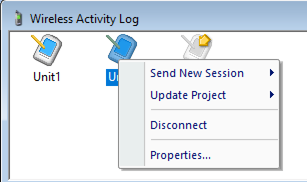 |
Use on Android Device
The MDS icons of installed projects are shown in the Project Window. Below are shown Example projects provided in C:\Program Files (X86)\Mobile Data Studio\Examples\ ; install the Examples to test the system, they can be deleted afterwards (tap and hold on project icon to Delete). Click on a project icon to 'Show Sessions Menu' displaying folders for Active Sessions, Sent Sessions and Deleted Sessions. The Sent folder provides reference access for users in the field to sessions that have been sent to Mobile Data Studio server. The Settings page provides a control for timing of 'purge' of Sent and Deleted sessions, from immediate out to 100 days. To avoid double entries in databases, sessions in the Sent folder cannot be re-sent to the Mobile Data Studio server. However, Sent and Deleted sessions can be Duplicated and returned to the Active folder.
Note two important icons in the Session Wiudow, a Search icon and a Cloud icon indicating when there is a wireless connection. The Search function applies to a selected Session List Column; for example,'Customer' in the image below..
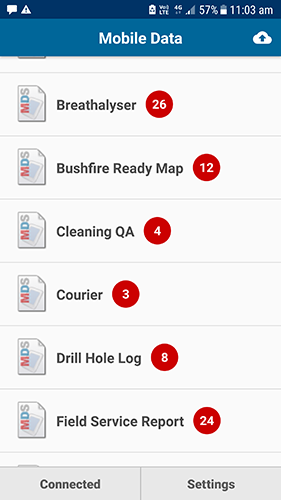 |
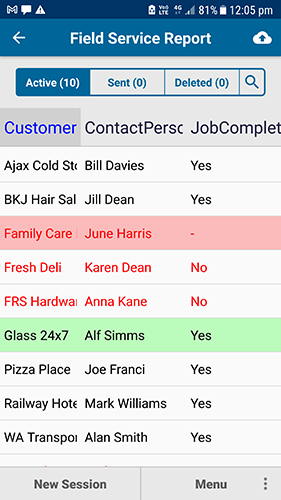 |
When opening the Active Sessions folder initially the Session Window will be blank, tap the 'New Session' button to open a session. Open sessions for the example Courier, Drill Hole Log and Office Workstation projects are shown below.
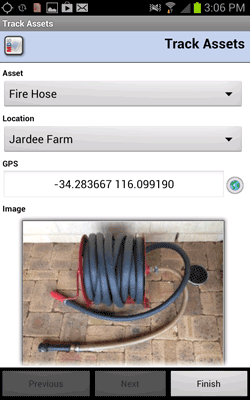 |
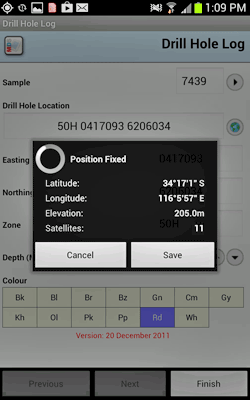 |
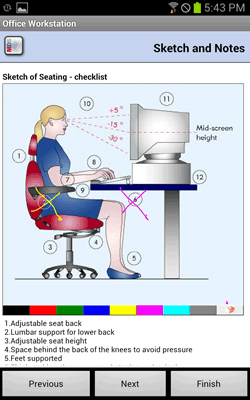 |
When sessions are finished or saved they appear in the Session Window awaiting further management, either via the Session Menu at the bottom of the screen (shown via device menu control), or by activation of Selection Mode which enables selection of a specific session and display of menu for managememt of the session. These controls apply both to sessions filled on the Android device and to sessions sent to the Android client device by the Mobile Data Studio server. Sessions that have arrived from the Mobile Data Studio server are shown in red. Marked sessions can be sent to the Mobile Data Studio server via TCP/IP either individually or in a batch; they are shown in green, which may appear as gold on some devices. Please review page 11 Wireless (TCP/IP) functions to understand their operation. The Duplicate function applies to individual selected sessions, providing a convenient duplicate of data, but as a unique new session.
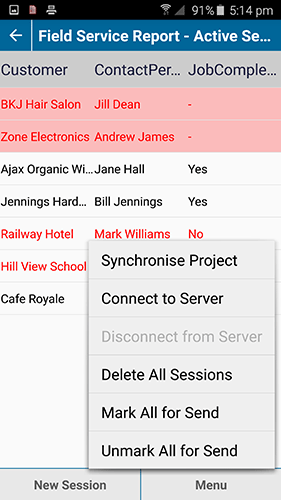 |
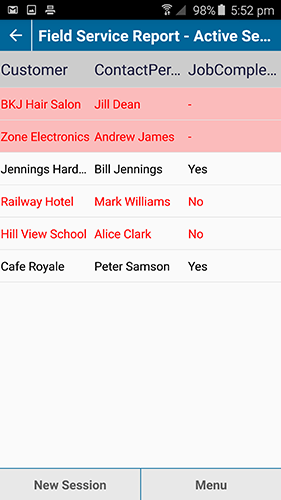 |
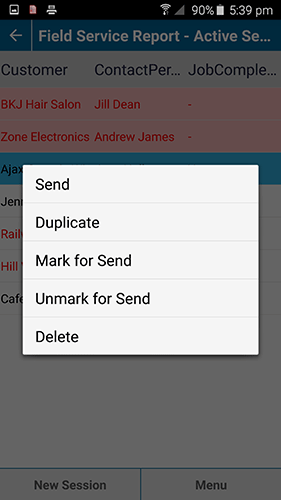 |
Session List Columns are resizable by dragging on the column heading, columns manual adjustment can be reset back to zero by double tapping on the session column heading, user adjustments to sessions widths are saved and restored when the project is opened and closed, and tap to top of columns sorts sessions alphanumerically.
Translation of Menu LanguageThe Android client side controls can be translated (see example adjacent) and the translated file can be offered wirelessly to clients via an option in the server side wireless options to Offer language translation file (via Setup, see page 11 Wireless). This allows the language translation file, and any updates to it, to be distributed automatically. The ClientLanguage.ini file is found in C:\Program Files (x86)\Mobile Data Studio on the server and can be edited in Notepad. The INI file is organised in logical sections; for most purposes only the menus and text of buttons need to be translated. The INI text file can also be used to customise instructions to mobile users. When translating to Simplified Chinese the INI text file should be saved as Unicode format. Following translation of INI, maintain a copy outside of the Mobile Data Studio program folder as upgrades to Mobile Data Studio will replace the ClientLanguage.ini file with original. Copy translated ClientLanguage.ini back into Mobile Data Studio program folder after upgrade to Mobile Data Studio. The ClientLanguage.ini file also enables customisation of menus and 'pop up' messages. For example, UpdateProjectMessage="A newer version of this project is available. Would you like to download it?" Could be changed to: UpdateProjectMessage="A newer version of this project is available. You MUST download it." |
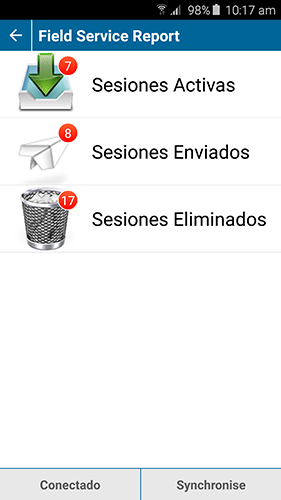 |
Tethering and Hotspot in AndroidWhile the standard Mobile Data Studio deployment using wireless TCP/IP is used for multiple mobile clients to connect to Mobile Data Studio server, a TCP/IP connection can be made using the 'Tethering' and 'Hotspot' functions in Android, see screenshot on right. These communications can be useful when Mobile Data Studio is deployed in remote areas away from mobile phone and WiFi networks. Tethering is conducted using the USB cable provided with Android devices. The appropriate IP address will be shown in the wireless Activity Monitor. With use of the wireless Hotspot functions, the mobile device is providing the WiFi network to which is connected a laptop or notebook computer hosting Mobile Data Studio server. When using these functions, either USB or WiFi should be used, not both at the same time. |
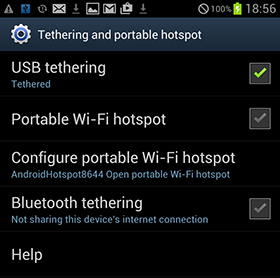 |
 Previous Page Previous Page
|
Jump to page: |
Next Page 
|


